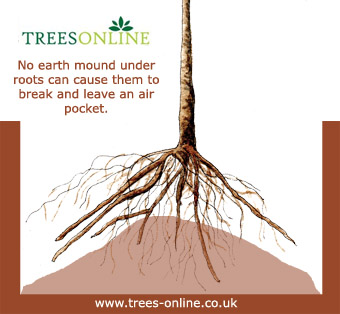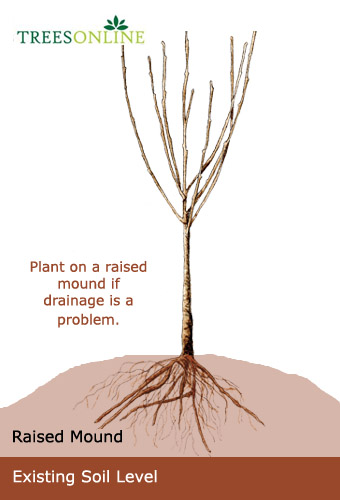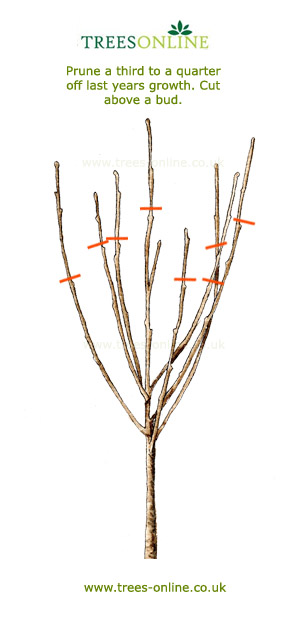Planting Bare Root Ornamental, Hedging And Fruit Trees, Beginner V's Purist
As a total beginner, I once had an afternoon to plant 34 fruit trees. The soil was very heavy clay, it had weeds everywhere, spacing was 1m or less, I never measured the hole depth, broke up the soil, shaped the hole, pruned the tree, staked or added anything other than sweat and a few curses from a sore back. I heavily compacted the soil with my 120 kg size 11's and every single one survived and fruited. I will never know if my "caveman planting" could have given better results.
The Purist Method Of Planting Bare Root Trees
If you want to be a little more structured and put more effort into bare tree planting than most people do with their relationships then the following is for you.
Basic Principles
So long as you achieve a few principles, how you reach them is not important. They are:
1) Your bare root tree must be planted in a spot that ensures enough sun and water.
2) The roots cannot dry out and damage to them kept to a minimum, especially the smaller roots.
3) They must be in contact with and supported by a fertile, moist and free draining soil with minimal to zero air pockets.
4) The grafting union (slight bulge at the bottom of the tree) must be above ground level.
The following planting approach is arguably a purist version.
Soaking The Bare Root Of Your Tree
Prune out damaged roots and trim the tips off the larger roots before soaking them for about 30-60 minutes as they may have dried a little. Removing the tips aids the uptake of water.
Remove Surrounding Weeds And Plants
Remove any plant life within a 1 metre radius of the tree you are planting as grass and weeds offer significant competition. If your neighbours garden is within 1 metre, this is not permission for you to get your machete out and start screaming "BANZAI!!" at their Wisteria. If you ignored us and screamed "BONSAI!!", you got the wrong end of the stick.
Start Digging A Square Hole
As the roots spread out, they will encounter soil more compacted than the hole they were placed in. If the hole is round, it could be argued they will direct the roots to spiral instead of spread.
Make the hole twice the width of your root system and about 10cm deeper. This is to break up the dirt the roots will first encounter and hopefully speed up establishment of your bare root tree.
Have a means of capturing the excavated earth e.g. wheelbarrow or tarpaulin if the planting spot is surrounded by grass. Throwing the dirt onto grass means you are unlikely to retrieve all of it back.
Poor Quality Soil
Compost out of the bag is a great guideline to excellent soil. Usually a dark brown to black colour and very crumbly. Squeeze a handful of it and you can make a solid shape. It will hold moisture but allow excess water to drain. Soil full of sand will not retain a shape when compressed, will have low fertility and be too free draining. A hard clay soil is difficult to break up and give the roots a hard time growing through it. Somewhere in the middle is ideal; the Goldilocks zone. You could use 100% compost but it will require more firming than usual. will have less resistance to wind loads and will probably need staking.
Soil exposed by removing a building, path etc will most likely be compacted and of low quality. If you have doubts about your soil, mix the excavated soil 50:50 with compost, well rotted manure or other soil additive of your choice. If mixing in a fertilizer, some is good, more is not better. You can put too much in which harms the tree so ensure you follow the instructions.
 The Whole Reason You Are Doing This, Planting The Bare Root Tree
The Whole Reason You Are Doing This, Planting The Bare Root Tree
However you plant your bare root tree, treat the smaller roots with kid gloves. Trees over a few years old have thicker more established roots that are more difficult to bend and damage. You could shovel clay lumps into the hole and not make a significant difference. 2-3 year old bare root trees are very different.
Many root systems grow outwards in a sort of umbrella shape leaving an empty space underneath the main stem of the tree. To prevent the roots being bent upwards and breaking, build a dome at the bottom of your hole and firm well. Make the dome high enough so that when you place your bare rooted tree on top of the mound, the old soil line is in line with your current soil level. A few cm either way will do no harm. A straight edge across the hole will help you gauge correct height.
Some trees are grafted which means you will see a bulge in the trunk usually within 30cm of ground level, make sure you do not bury that. If in doubt, use half way between the first bulge and first roots or around 10 cm above the highest/first root.
If you are going to stake, now is the time to do so. Knock the stake in until the stake feels firm at the end. With a few kg's of force it should move only a cm or two at the top (based on a 1.0 to 1.5m long stake) For most of us, the prevailing wind is from the West, so your tree needs to be planted east of the stake. This stops the wind damaging your bare root tree and creating an entry point for disease.
If you choose to use a fungal additive over the roots, now is the time to use it according to the suppliers instructions. Place the main trunk of your bare rooted tree over the top of the mound and spread the roots out so the lowest roots are draped over the mound and pointing  away from the tree which should be the direction they naturally sit at. What you need to avoid is bending or breaking any of the root system if possible as you replace the dirt. Use the finest soil to sprinkle over the roots and fill any gap left at the top of the mound and start of the tree.
away from the tree which should be the direction they naturally sit at. What you need to avoid is bending or breaking any of the root system if possible as you replace the dirt. Use the finest soil to sprinkle over the roots and fill any gap left at the top of the mound and start of the tree.
Getting someone to view the tree as you are planting will make sure it points to the sky and not the bins. No spirit levels are required, uncalibrated eyes will do.
We suggest replacing the dirt in 10 cm layers. Gently firm the 10cm layer. As to how firm, think kneading bread not pushing a King Cobra away from your throat.
Then take the middle section of roots and repeat. The taller the root system, the more layers you will need. This method means all the roots are surrounded by dirt with no air gaps and supported. This means the tree is firmly embedded into the soil and less likely to experience wind rock.
Leave the last layer unfirmed as this improves water take up. A firmed layer could allow the water to travel away from the tree. Some arborists will "dish" the last layer or build a ring of dirt around the tree to keep or move water towards the rootball.
Your Local Water Table Or Poor Drainage
If you dig your hole and it fills with water, you either have a high water table, very poor drainage, hit a water main or didn't notice the monsoon. It amounts to that same thing, your tree roots will spend more time underwater than they are happy with. You either need to improve drainage or raise the level of the tree. Improving drainage is the harder option, simply adding topsoil to your existing topsoil and creating a raised bed is the easiest. If you choose to simply create a raised mound to plant in, you are most likely going to require a tree stake. Make the mound around 30cm tall and tapering off to 1m away.
Mulching Bare Root Trees
Consider using a mulch around the base of the tree. Bark, decorative stones etc over a weed suppressant fabric is a decorative and practical choice. It reduces evaporation and keeps competing plant life to a minimum. Grass clippings are not a good idea. Keep all mulch's away from direct contact with the tree as they can cause bacterial/fungal/physical damage.
If you have a rabbit population nearby, consider using a spiral guard or other rabbit protection. Training a lion or tiger to stand guard is very effective but fraught with legal issues. Once a tree has been girdled it will die. This is where a strip of bark is removed around the whole circumference of the tree.
If the tree is suitable for pruning (some prefer to be left alone except for removing dead, diseased and crossed over branches) then trim the branches back by a third to a half. Not only does this promote future bushiness but you are balancing the roots with the foliage. You should  not have a large head of branches and leaves with a very small root system. This can cause problems e.g. high winds.
not have a large head of branches and leaves with a very small root system. This can cause problems e.g. high winds.
Pruning Your Bare Root Tree Once Planted
You have paid good money for your tree, why would you want to hack bits off it? When in the fields before sale bare root trees are pulled from the ground leaving some of the fine feeding hairs behind. The root system can also be trimmed at the nursery for various reasons. So the tree had a larger root system and now you have it as a smaller system which means it might not be large enough to support the branches above. Pruning re-balances the foliage to root ratio i.e. small roots are unlikely to hold up a large tree in high winds.
Also, you are likely to receive a 2-3 year old tree which means it will require formative pruning whereby you need to remove a third to a quarter of last years growth. Pruning is a long subject but in summary, you want to avoid long and thin branches because they will be weak and snap under wind, snow and fat pigeon loads. This is a much more important issue with fruit trees. All bare root trees are supplied when dormant i.e. no leaves and you can easily identify the previous Summers growth. It may feel wrong but it absolutely is the right thing to do. There are a few trees that should never be pruned but the nursery should tell you this.
The Sources Of Our Information For Planting Bare Root Trees
We looked at many videos, books and websites of leading UK nurseries and universities with an equal amount from the experienced and hands on. Not one guideline was the same. The point being there is no one right way to plant bare root trees.